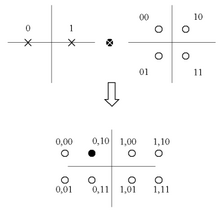Background
Superposition coded (SPC) modulation is a physical-layer technique conventionally enabled by a hardware circuitry that allows a transmitter to send individual information to multiple receivers within a single wireless broadcast signal. Studies performed on cross-layer design for generating wireless multicast signals for transmitting scalable video streams showed that the SPC multicast for scalable bitstreams can fully explore the channel capacity in presence of channel fluctuation and user channel diversity by superimposing multiple quality layers into a single SPC modulated signal.
Using SPC modulated signals, receivers with poor wireless channels decode and obtain the base layer data for a basic video perceptual quality, while receivers with good channel conditions can obtain, in addition to the base layer, the higher quality layers to refine the data from lower layers for improved video quality.
In spite of the aforementioned advantages, SPC modulation has been rarely employed in any commercially available wireless system or industry standard. This is likely due to the requirement of dedicated hardware components and circuitry to superimpose two or multiple modulated signals to form a SPC signal at the physical (PHY) layer.
Description of the invention
University of Waterloo researchers have developed a novel cross-layer design framework of logical superposition coded (L-SPC) modulation for multicasting successively refine-able information such as scalable video bitstreams. It mitigates the vicious effect of multi-user channel diversity by logically realizing an immediate and practical implementation of SPC modulation.
The developed framework manipulatively mimics the conventional SPC (CSPC) modulation for any combination of common M-ary modulation techniques adopted in current wireless standards. As a result, neither the transmitter nor the receiver requires additional hardware to encode/decode the signal. At the receiver side, a strategic mapping of refineable information bits from the base and enhancement quality layers into an LSPC signal is performed using advanced features of modern chipset designs that enable dynamic energy allocation and phase shift assignment. Demodulation at the receiver does not need any dedicated SPC hardware, as the industry standard demodulators can be well employed to demodulate the L-SPC signal.
Advantages
- Efficient wireless multicast
- No additional hardware needed
- SIC (Signal Interference Cancellation) not needed at the receiver

Fig. 1 Constellation diagram for a three bit wrapper of two conceptual quality layers where the base layer is represented by one bit and the enhanced layer is represented by two bits. If a receiver can detect for example any points in the left panel, it has detected a “0” from the base quality layer.

Fig. 2 Logical SPC multicast signal Generation
Reference
8810-7251
Inventors
Pin-Han Ho
James She
Patent status
US patent 8,755,412 issued
Stage of development
Fully simulated and technical data
generated
Contact
Scott Inwood
Director of Commercialization
Waterloo Commercialization Office
519-888-4567, ext. 43728
sinwood@uwaterloo.ca
uwaterloo.ca/research